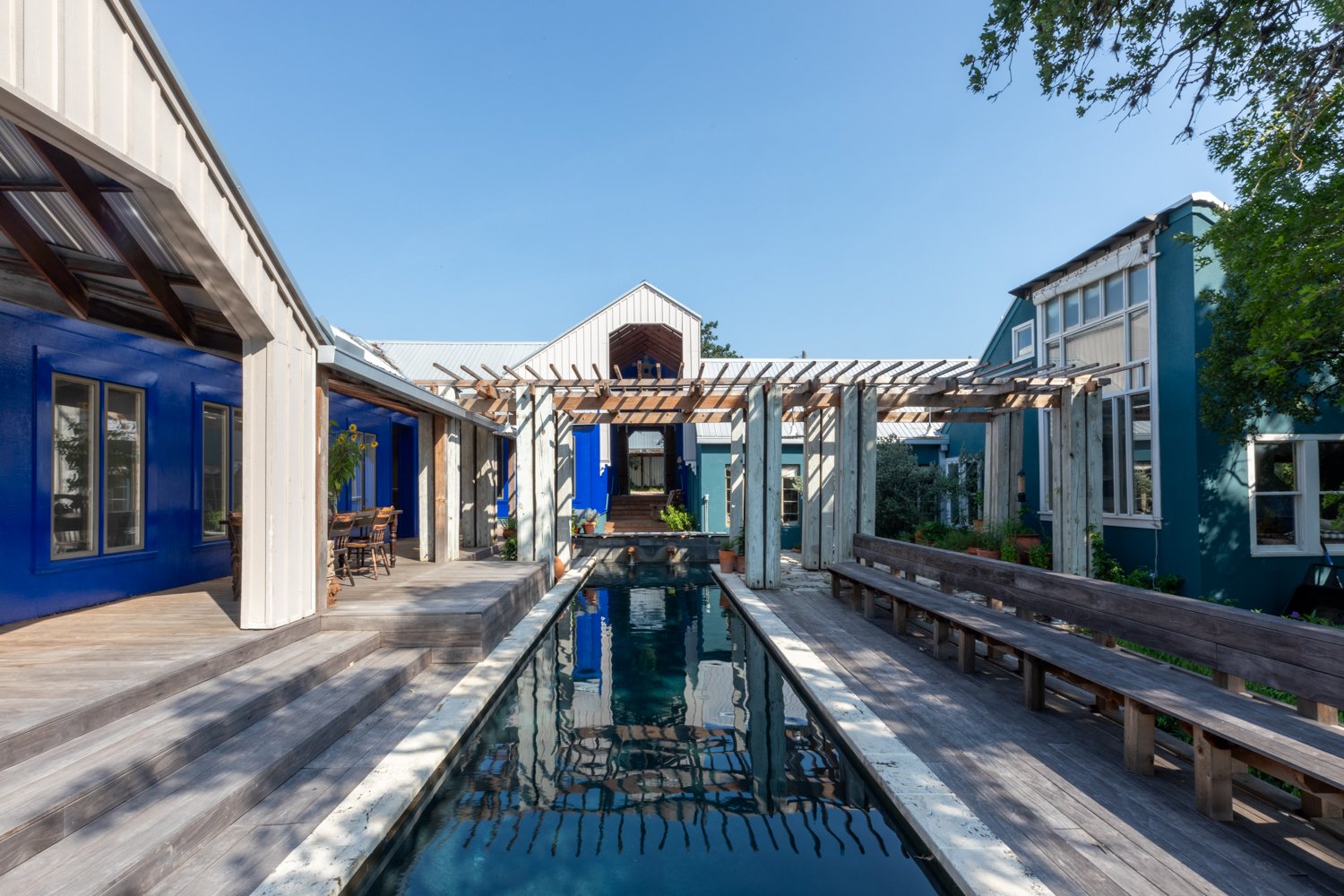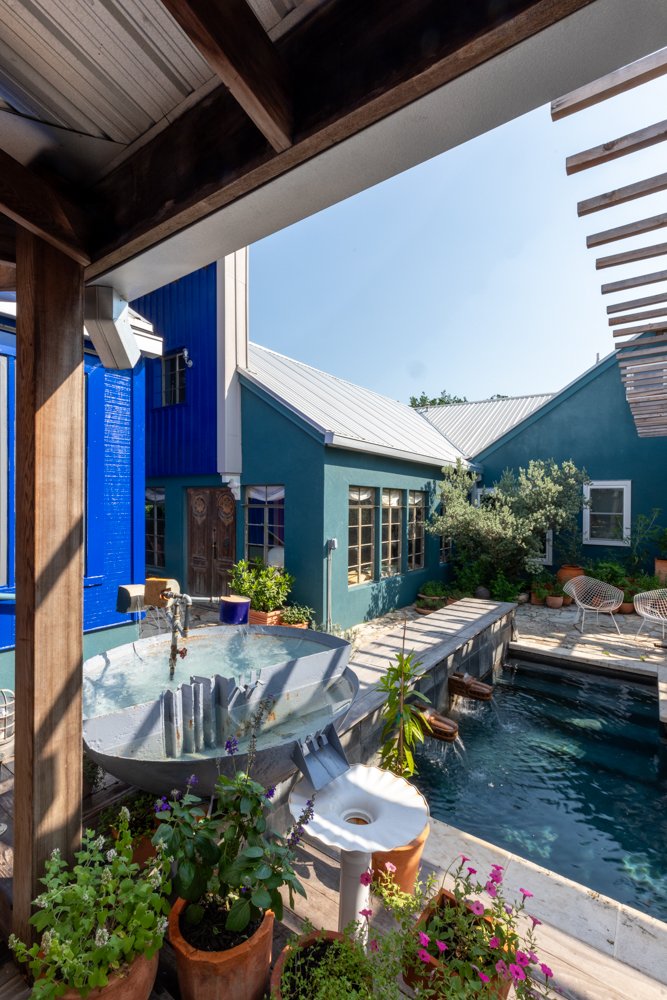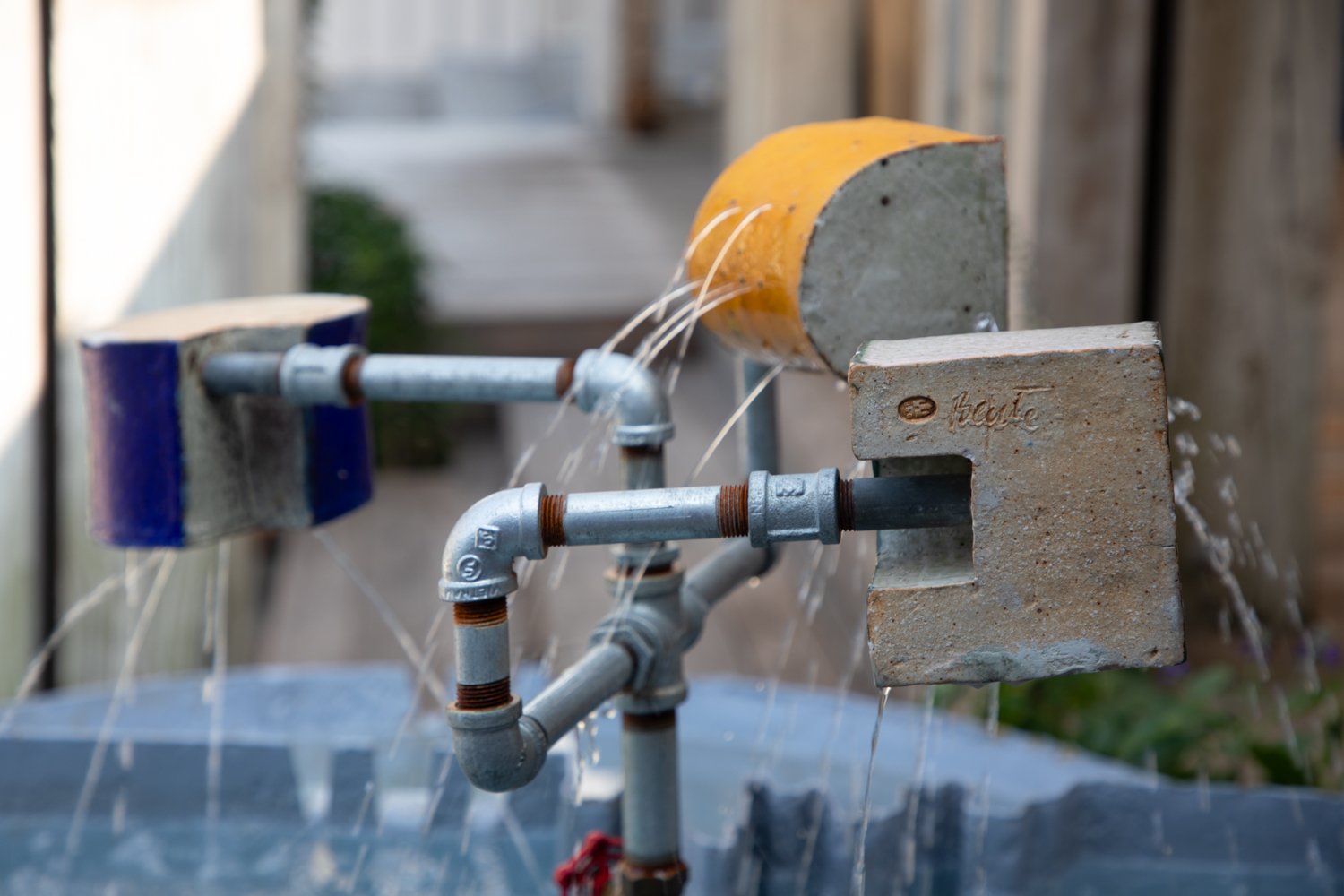
During the February 2021 Texas deep freeze known as Snovid, the Moore/Andersson Compound in Austin was fine—if having a decimated garden and needing to blast the pipes with a hairdryer in the middle of the night can be considered fine. “I went and rescued several friends whose power went out, who were freezing in their homes,” says Kevin Keim, the hands-on director of the Charles Moore Foundation, a nonprofit that owns and takes care of several buildings by Moore, the architect, who died in 1993.
Two winters later, the compound, which Moore designed in 1987 with business partner Arthur Andersson, and which is widely considered to be a postmodern masterpiece, wasn’t so lucky. “During one of the freezes, the pool pump froze and burst, and all the basin water drained into the Gulf of Mexico,” Keim recalls.
Gazing at the empty rectangle, he saw an opportunity. First, to replace the old pump with something more energy-saving and freeze-resistant, and second, to restore the pool to its original color: a deep charcoal that, thanks to the interplay of water and light, makes the filled basin appear an intense blue. “For the preservation of buildings in Texas, UV is a killer,” he says. “It’s just relentless.”
Heat, cold, flooding: extreme weather, increasingly common as the planet warms, poses new obstacles to prolonging the life of a home. Learning from the best of its idiosyncratic design, Keim realized, should be the starting point for future-proofing a compound that was always ahead of its time.

For a typical homeowner, replacing the pool is an expense and an annoyance; a Charles Moore house without water hardly seems like a Moore house at all. From his first self-designed abode, a one-room personal temple in Orinda, California, with a tub and shower as part of the living space, Moore used water as a focus and a thread, a way of bringing people together and leading them where he wanted them to go. With a rotating series of partners, he designed fountains for plazas in Pasadena, Portland, and New Orleans, as well as the striking pools at Sea Ranch on the California coast.
Even today, for most visitors the pool is the pleasure of the Austin compound: You have to walk past it to access Moore’s house, Andersson’s house, the residential Cube Loft, and both of the on-site work studios. The perpetual flow of water from a pair of replica Mesoamerican cat fountainheads masks the sound of traffic from the road below the site, aiding in the fantasy that you are on a Mediterranean hillside.
The title of Moore’s 1957 Ph.D. thesis at Princeton was “Water and Architecture” and, as he wrote, “dissatisfaction is the provocation for every thesis.” At that time, “if there was a pool, it was a kind of dead pool,” says architect Donlyn Lyndon, who met Moore at Princeton, and was later his co-author and design partner. “Even at the Campidoglio in Rome, you were somewhat restricted from putting your hand in the water. Engagement was not part of the composition.” For Moore, he continues, water “is part of having an architecture in which you really engage, in which a person can touch things.”
When The New York Times wrote about Moore’s 2,220-square-foot Austin residence, in 1987, the paper referred to it as “The Kingdom of What Can Be.” A peaked tower marks the entrance to the compound, through a galvanized aluminum gate whose flamelike top suggests that something special is going on inside. The gate opens into a long covered hallway, its walls painted a brilliant cobalt blue, visually doubling the length of that always-in-motion lap pool. “His chief pleasure in this house,” the Times wrote, “is the play of dappled light, which sparkles off the pool and enters through hidden upper windows, dancing around the angles of the ceiling.”
“I think Charles thought of a lot of his buildings as ephemeral. But they are such wonderful documents of the thinking of that time,” says Larry Speck, an architecture professor and former dean at the University of Texas at Austin. In 1985, his office was next door to Moore’s, and he witnessed firsthand the impacts of the climate crisis on the area. “There is a drought periodically, and then a year in which it just rains like hell,” Speck says. “Austin has always had a very erratic climate of extremes, but now it is more erratic and more extreme.”

Pre-pandemic, Keim had already started restoring the compound, which includes structures from the 1930s, 1950s, and 1980s. Much of that DIY effort involves managing water: from replacing the roof and adding yards of new galvanized aluminum gutters, to establishing new water collection systems and replanting the gardens around the house with species better suited to Austin’s new plant hardiness zone. He wanted to do all that in a Mooresian spirit, however: “What would happen if Gertrude Jekyll met Esther Williams?”
Keim continues in the bric-a-brac tradition of his mentor, who cheerfully mashed up “booty garnered from his many travels,” as the Times wrote. Some of that booty only now reveals its purpose, including a rusted out pleated Smoot Holman lampshade that will reappear as a funnel, connecting a basin made from an old mine (don’t ask) to a new conduit under the deck, channeling water off the surface and into the gardens.
The booty also includes a set of yellow, green, and blue glazed ceramic fountainheads Keim discovered in the process of cataloging Moore’s folk art collection. After puzzling over the signature, he discovered that they were made by Danish ceramicist Bente Hansen, in 1968. Now, Keim says, they will be incorporated into that basin: “They’ll shoot water in a sort of Jean Tinguely way.”
His future efforts fan out from the pool into the larger landscape around the compound. He’s considering a new entrance “folly” at the end of the drive, constructed of translucent water totes, serving double duty as storage and welcome. Even as he replaces plants with native species, he wants to retain some of Moore’s love of formal Italian gardens: “Standard American lawn sprinklers would be synchronized so that when we twiddle the valves, great eyelashes of water would sweep back and forth across and all the way down the lawn.”
Linda Taalman, a Los Angeles–based architect who had an overnight at the compound this spring, posted photos on Instagram to memorialize her stay. One is, naturally, of the pool at sunset, the rippling water reflecting the pergola and trees. “In some ways this was very much an adaptive reuse project,” she says. “And once Kevin has his water collection system going, that is the next chapter. You have this piece of history and you are continuing to keep it alive, but you are also going somewhere new with it.”